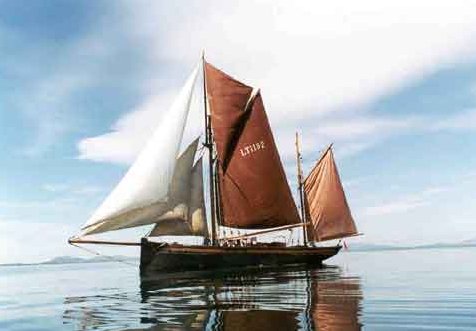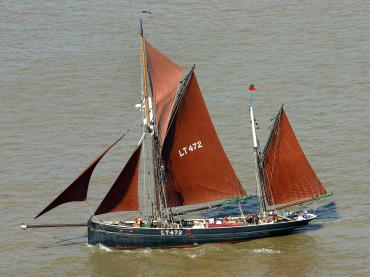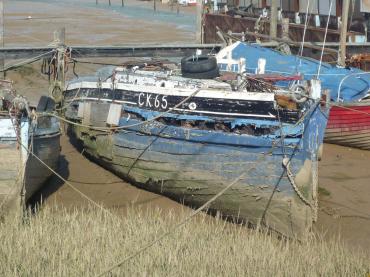


Previous names
- 1944 - 1985 Vastenwind
- 1985 - 1989 Odysseus
- 1989 - 1989 Alice A
Details
Construction
Dimensions
History
Believed to be the only surviving Rye-built sailing smack, KEEWAYDIN was launched in 1913 by G & T Smith, of Rye, for Lowestoft owners, and registered with the number LT 1192. She was built of carvel oak planking on oak frames, and her design and rig was based on the Brixham sailing trawler.
KEEWAYDIN fished out of Lowestoft on the North Sea banks until 1937. She then went to Denmark and later Sweden for coastal cargo carrying, with a 60 hp Bolander oil engine installed; she was renamed Vastenwind in 1944. During the Second World War she also carried refugees from Denmark to neutral Sweden and on one trip carried a total of 420 commandos. She was also believed to have been involved in gun running.
In 1963 she was converted into a yacht and in 1973 was entered into the first Whitbread Round the World Yacht Race, and completed the circumnavigation. In 1974 she went to the Greek islands as a charter yacht and her rig was altered to two Bermudan sails. In 1985 she was renamed Odysseus. In 1989 she was bought by Adrian Amos, renamed Alice A, and went to Malta for major repairs. Later Amos renamed her Keewaydin again.
In August 1997 she was bought by her present owners at Malta after the previous owner’s restoration project had failed. She was sailed to Brixham in 1998 where her restoration to the original gaff rig was finally completed. In 2001 KEEWAYDIN sailed again as a charter and holiday yacht based at Cardigan, west Wales, and sleeping twelve guests. She was damaged in September 2005 when on charter to a London sailing school using their own crew. An eighteen month rebuild followed, repairing the counter and starboard side. She was then mostly employed taking disadvantaged Carmarthenshire children to sea for adventure training.
In 2008 her base became Falmouth, Cornwall which opened up opportunities for holiday voyages to the Scillies, Brittany, and beyond. In 2011 a new mainmast was stepped. At about midnight on 1/2 June 2011 KEEWAYDIN ran aground on an outcrop between the Scilly islands of Tresco and Bryher. The fourteen people on board were taken from the vessel to the shore by a local boat. The crew and a fire and rescue service crew from the island used a pump to keep the boat afloat overnight, and after about six hours she was refloated on the high tide and beached on Bryher for repairs.
Following the tragic death of her owner in 2021, a new owner was sought for KEEWAYDIN. As of October 2022, she was under the ownership of the KEEWAYDIN Voyage Group who intend to restore KEEWAYDIN as a sail training vessel.
Source: Historic Sail, Britain's surviving working craft, Paul Brown, the History Press.
Significance
What is the vessel’s ability to demonstrate history in her physical fabric?
Evidence for designs, functions, techniques, processes, styles, customs and habits or uses and associations in relation to events and people. How early, intact or rare these features are may impact on significance.
KEEWAYDIN is a sailing smack built in 1913 by G & T Smith of Rye for Lowestoft owners. Her design and construction exhibit elements inherent in both Rye and Lowestoft built vessels with her elliptical counter stern typical of Lowestoft constructed sailing trawlers, whilst her frame spacing and coupling is customary to Rye. As such, she is a hybrid of the two ports in terms of traditional sailing trawling design and construction.
The vessel has gone through different phases in her working life, changing from fishing vessel to cargo vessel to yacht and now charter vessel. Internal layout changes required by these roles were made resulting in alterations to internal bulkheads, cabin partitioning and accommodation, plus additional deck structures and machinery. Her fabric shows evidence of the various operational demands made on the vessel, thus reflecting her history.
Major works at key points between 1963 and today have included replacement of half the keel, the stem, plus a large proportion of hull frames and planking with approximately 25-30% of her original hull fabric remaining. Her decks, coach roof, rigging, machinery and fittings have also been replaced during maintenance and refits as her primary usage has changed. These works were carried out sympathetically, although with some use of alternative timbers and steel structural elements. Despite these interventions, her hull shape remains as built. The original Rye frame layout is still visible and has been somewhat maintained throughout the various past conservation work.
What are the vessel’s associational links for which there is no physical evidence?
Associations with people or places. Off-ship research.
KEEWAYDIN is one of a small number of surviving sailing trawlers from the early twentieth century, which were built and operated in large numbers around the UK coast prior to the advent and widespread introduction of steam powered vessels. Being build in Rye for Lowestoft owners she has obvious associations to these two ports. Nationally she represents an era of change as the fishing industry was developed from localized subsistence to fishing on an industrial scale. Whilst vessels of this type were the pinnacle of fishing under sail, they were soon to be replaced by steam drifters and motor driven vessels able to travel greater distances to search out and land catches. Linked to the developing infrastructure of towns and ports around our coastline, and the rail links from major cities to the coast it was a time of dramatic social and economic change for the nation as a whole. KEEWAYDIN plays an important part in telling this story in the context of the industrial revolution and is believed to be the only surviving Rye built sailing smack.
KEEWAYDIN also has strong international associations following her withdrawal from the UK fishing industry in 1938. She spent time in Sweden and Denmark, then later operated in Greece as a yacht before moving to Malta for repairs. During the Second World War she is significant for carrying refugees from Denmark to neutral Sweden and on one trip carried a total of 420 commandos. She was also believed to have been involved in gun running. In 1973, she took part in the first Whitbread Round the World Race. KEEWAYDIN has been featured in a number of film and television productions, including the television series ‘Edwardian Farm’. She was recorded on the National Register of Historic Vessels in 2008.
How does the vessel’s shape or form combine and contribute to her function?
Overall aesthetic impact of the vessel, her lines, material she was built from and her setting. Does she remain in her working environment?
KEEWAYDIN’s primary function, as built, was for trawling in the Southern North Sea and her strongly built carvel oak hull reflects the conditions she would have experienced. The aesthetic impact of the vessel, her lines and material fabric, as well as the hull form and construction, are representative of her working history. Elements of speed, stability, sea-kindliness, functionality, ease of handling, safety, and aesthetic and mechanical elegance, were all brought together in sailing fishing craft of this kind.
The introduction of steam capstans to assist both with sail setting and handling the fishing gear led to the development of larger 70ft smacks like KEEWAYDIN that were better suited to the offshore conditions. Each port developed its own versions with Lowestoft vessels exhibiting an elliptical counter stern and a mizzen mast raked forward. Sheets and halyards were handled by the skipper via the steam capstan allowing the rest of the crew, mate and two deckhands, to manage the nets and catch. The ketch rig was specifically chosen as a combination of sails that could be used to move the vessel sideways over the ground, or provide the power needed to pull the heavy trawl gear forward.
KEEWAYDIN is no longer based in the North Sea waters where she once worked but is now in the South-West, where she is stabilized on a floating dry dock pending conservation to return her to operational use.
Sources:
Greenhill, B, & Mannering, J. Inshore Craft. (Seaforth Publishing, 1997, Pages 73-75)
Brown, P. Historic Sail. (The History Press, 2013, Page 53)
Author: Vessel Owner & NHS-UK, March 2023
Grants
-
Financial year April
A Sustainability Grant of £3000 for new sails was made from the Strategic Development Fund of National Historic Ships
Sources
Rye Vessels, Rye Local History Group
Classic Boat: Charter UK Destinations - Wish you were here?, Edition 273, February 2011
Classic Boat: Brixham Trawler Keewayadin remembers, June, 2004
Own this vessel?
If you are the owner of this vessel and would like to provide more details or updated information, please contact info@nationalhistoricships.org.uk






